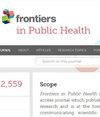厘清水库丰度和病原体脱落对城市非正规住区钩端螺旋体病原体人畜共患病蔓延的影响
IF 3
3区 医学
Q2 PUBLIC, ENVIRONMENTAL & OCCUPATIONAL HEALTH
引用次数: 0
摘要
老鼠是致病性钩端螺旋体(导致钩端螺旋体病的细菌)的主要贮藏地,尤其是在城市非正规居住区。然而,老鼠数量和病原体脱落率的变化对人类外溢传播的影响仍不清楚。本研究旨在调查在巴西城市非正规居住区中,鼠群数量和病原体压力的空间变化如何影响钩端螺旋体向人类的外溢传播。在2013年至2014年期间进行了一项纵向生态流行病学研究,以确定大鼠丰度和大鼠钩端螺旋体脱落率的空间分布特征,并确定与2206名社区居民中人类感染风险的关联。使用追踪板和活体诱捕来测量老鼠的数量,并量化老鼠的脱落状况和负荷。与此同时,还利用四次连续的半年期血清调查来确定人类钩端螺旋体感染情况。为了评估大鼠脱落对人类风险的影响,我们建立了三个统计模型:(1) 大鼠的相对数量;(2) 大鼠个体的脱落率;(3) 人类钩端螺旋体感染,其中 "总脱落率"(由这两个模型的预测值相乘得出)被用作风险因素。我们发现,钩端螺旋体的脱落与年龄较大和性成熟的老鼠有关,并且在空间和时间上存在差异--谷底和季节性降雨(12 月至 3 月)时脱落率较高。老鼠种群的 "总脱落 "点估计值为正,即钩端螺旋体感染风险随总脱落量的增加而增加,但相关性并不显著[几率比(OR)= 1.1;95% 置信区间(CI):0.9, 1.4]。这一正向趋势主要是由老鼠数量而非单个老鼠脱落所造成的(OR = 1.8;95% CI:0.6,5.4 vs. OR = 1.0;95% CI:0.7,1.4]。在植被覆盖较多的地区(OR = 2.4;95% CI:1.2,4.8)和洪水进入房屋的地区(OR = 2.4;95% CI:1.6,3.4),感染风险较高。我们的研究结果表明,与老鼠相关因素相比,环境和水文因素在钩端螺旋体外溢中起着更重要的作用。此外,我们还开发了一种结合多种模型的新方法,以阐明动物储库丰度、病原体脱落和环境因素对人畜共患病溢出之间的复杂联系,该方法可扩展到其他环境传播疾病。本文章由计算机程序翻译,如有差异,请以英文原文为准。
Disentangling the influence of reservoir abundance and pathogen shedding on zoonotic spillover of the Leptospira agent in urban informal settlements
Rats are major reservoirs for pathogenic Leptospira , the bacteria causing leptospirosis, particularly in urban informal settlements. However, the impact of variation in rat abundance and pathogen shedding rates on spillover transmission to humans remains unclear. This study aimed to investigate how spatial variation in reservoir abundance and pathogen pressure affect Leptospira spillover transmission to humans in a Brazilian urban informal settlement. A longitudinal eco-epidemiological study was conducted from 2013 to 2014 to characterize the spatial distribution of rat abundance and Leptospira shedding rates in rats and determine the association with human infection risk in a cohort of 2,206 community residents. Tracking plates and live-trapping were used to measure rat abundance and quantify rat shedding status and load. In parallel, four sequential biannual serosurveys were used to identify human Leptospira infections. To evaluate the role of shedding on human risk, we built three statistical models for: (1) the relative abundance of rats, (2) the shedding rate by individual rats, and (3) human Leptospira infection, in which “total shedding”, obtained by multiplying the predictions from those two models, was used as a risk factor. We found that Leptospira shedding was associated with older and sexually mature rats and varied spatially and temporally—higher at valley bottoms and with seasonal rainfall (December to March). The point estimate for “total shedding” by rat populations was positive, i.e., Leptospira infection risk increased with total shedding, but the association was not significant [odds ratio (OR) = 1.1; 95% confidence interval (CI): 0.9, 1.4]. This positive trend was mainly driven by rat abundance, rather than individual rat shedding (OR = 1.8; 95% CI: 0.6, 5.4 vs. OR = 1.0; 95% CI: 0.7, 1.4]. Infection risk was higher in areas with more vegetative land cover (OR = 2.4; 95% CI: 1.2, 4.8), and when floodwater entered the house (OR = 2.4; 95% CI: 1.6, 3.4). Our findings indicate that environmental and hydrological factors play a more significant role in Leptospira spillover than rat associated factors. Furthermore, we developed a novel approach combining several models to elucidate complex links between animal reservoir abundance, pathogen shedding and environmental factors on zoonotic spillover in humans that can be extended to other environmentally transmitted diseases.
求助全文
通过发布文献求助,成功后即可免费获取论文全文。
去求助
来源期刊

Frontiers in Public Health
Medicine-Public Health, Environmental and Occupational Health
CiteScore
4.80
自引率
7.70%
发文量
4469
审稿时长
14 weeks
期刊介绍:
Frontiers in Public Health is a multidisciplinary open-access journal which publishes rigorously peer-reviewed research and is at the forefront of disseminating and communicating scientific knowledge and impactful discoveries to researchers, academics, clinicians, policy makers and the public worldwide. The journal aims at overcoming current fragmentation in research and publication, promoting consistency in pursuing relevant scientific themes, and supporting finding dissemination and translation into practice.
Frontiers in Public Health is organized into Specialty Sections that cover different areas of research in the field. Please refer to the author guidelines for details on article types and the submission process.
 求助内容:
求助内容: 应助结果提醒方式:
应助结果提醒方式:


